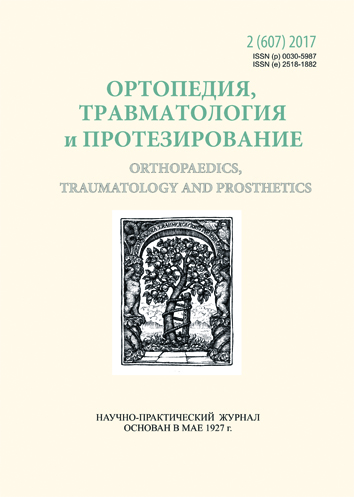Escobar syndrome (multiple pterygium syndrome) associated with osteogenesis imperfecta: a case report
DOI:
https://doi.org/10.15674/0030-59872017297-100Keywords:
Escobar syndrome, imperfect osteogenesis, bone fractures and deformations, hereditary diseasesAbstract
A clinical case of a unique combination in a patient of a combination of rare genetic diseases — imperfect osteogenesis and Escobar syndrome is presented. Imperfect osteogenesis (osteogenesis imperfecta, congenital fragility of bones, periosteal dystrophy, intrauterine rickets, osteopsaturosis, Lobstein-Wolff disease, «crystal» disease) [Q 78.0] — heterogeneous hereditary disease, with a frequency in the population from 1–7.2:10 000 to 1:20 000. Characterized by a violation of the synthesis of type I collagen. Clinically manifested by multiple fractures and the development of progressive deformities of long bones of extremities, some variants of the disease are accompanied by the presence of blue sclera and progressive deafness. Escobar syndrome (multiple pterygium syndrome, Multiple pterygium syndromes, OMIM 265 000) is an orphanic hereditary disease, the incidence is unknown. Clinical manifestations — cervical, antecubital, popliteal pterygiums, multiple contractures of joints, excessive skin folds in the axilla and between the fingers, congenital or early manifested scoliosis or kyphoscoliosis, the presence of hemivertebra, partial fusion of vertebral bodies, cryptorchidism and hypogonadism in boys, fetal akinesia, low hair growth at the back of the head, deformity of the feet as a «rocking-stop», intrauterine growth retardation, small growth, craniofacial dysmorphisms (micrognathia), antimonyholoidal incision of the eyes (displacement of the medial edges of the optic gaps upwards) with epicanthus or without it, ptosis, arachnodactyly, respiratory distress syndrome (due to hypoplasia of the lung tissue), cleft hard and soft palate, low set eyes. Intellectual development, as a rule, does not suffer. Treatment is complex: correction of metabolic disorders, surgical interventions to eliminate deformities of limbs, cleft palate, pterygium.References
- Bussiere JA. L’homme au cou de Chapelle, developpement anormal d’un faisceau musculaire acromiomastoidienne rudimentaire, malformation congénitale rare, observé à Pondicherry (index orientales). Annales d’hygiène et de médecine colonials. 1902;5:686–88.
- Escobar V, Bixler D, Gleiser S, Weaver DD, Gibbs T. Multiple pterygium syndrome. Am J Dis Child. 1978;132(6):609–11.
- Ramer JC, Ladda RL, Demuth WW. Multiple pterygium syndrome: an overview. Am J Dis Child. 1988;142(7):794–8.
- Van Dijk FS, Sillence DO. Osteogenesis imperfecta: Clinical diagnosis, nomenclature and severity assessment. Am J Med Genet. 2014;164A(6):1470–81. doi: 10.1002/ajmg.a.36545.
- Byers PH, Krakow D, Nunes ME, Pepin M. Genetic evaluation of suspected osteogenesis imperfecta (OI). Genet Med. 2006;8(6):383–8. doi: 10.109701.gim.0000223557.54670.aa.
- Sillence DO, Senn A, Danks DM. Genetic heterogeneity in osteogenesis imperfecta. J Med Genet. 1979;16(2):101–16.
- Morgan NV, Brueton LA, Cox P, Greally MT, Tolmie J, Pasha S, Aligianis IA, van Bokhoven H, Marton T, Al-Gazali L, Morton JE, Oley C, Johnson CA, Trembath RC, Brunner HG, Maher ER. Mutations in the embryonal subunit of the acetylcholine receptor (CHRNG) cause lethal and Escobar variants of multiple pterygium syndrome. Am J Hum Genet. 2006;79(2):390–5. doi: 10.1086/506256.
- Seo J, Choi IH, Lee JS, Yoo Y, Kim NK, Choi M, Ko JM, Shin YB Rare cases of congenital arthrogryposis multiplex caused by novel recurrent CHRNG mutations. J Hum Genet. 2015;60(4):213–5. doi: 10.1038/jhg.2015.2.
- Forlino A, Marini JC. Osteogenesis imperfecta. Lancet. 2016;387(10028):1657–71. doi: 10.1016/S0140-6736(15)00728-X.
- Balasubramanian M, Sobey GJ, Wagner BE, Peres LC, Bowen J, Bexon J, Javaid MK, Arundel P, Bishop NJ. Osteogenesis imperfecta: Ultrastructural and histological findings on examination of skin revealing novel insights into genotype-phenotype correlation. Ultrastruct Pathol. 2016;40(2):71–6. doi: 10.3109/01913123.2016.1140253.
Downloads
How to Cite
Issue
Section
License
Copyright (c) 2017 Sergey Khmyzov, Olena Sharmazanova, Nataliya Lysenko, Andrey Pashenko

This work is licensed under a Creative Commons Attribution 4.0 International License.
The authors retain the right of authorship of their manuscript and pass the journal the right of the first publication of this article, which automatically become available from the date of publication under the terms of Creative Commons Attribution License, which allows others to freely distribute the published manuscript with mandatory linking to authors of the original research and the first publication of this one in this journal.
Authors have the right to enter into a separate supplemental agreement on the additional non-exclusive distribution of manuscript in the form in which it was published by the journal (i.e. to put work in electronic storage of an institution or publish as a part of the book) while maintaining the reference to the first publication of the manuscript in this journal.
The editorial policy of the journal allows authors and encourages manuscript accommodation online (i.e. in storage of an institution or on the personal websites) as before submission of the manuscript to the editorial office, and during its editorial processing because it contributes to productive scientific discussion and positively affects the efficiency and dynamics of the published manuscript citation (see The Effect of Open Access).














